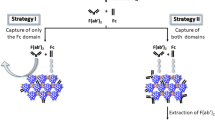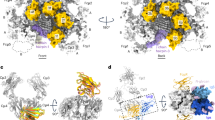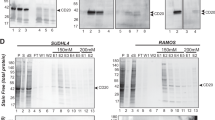Abstract
Immunoglobulin (Ig) molecules of the M and D classes are present on the membranes of B lymphocytes (sIg), where they serve as antigen receptors1–6. sIg is a biosynthetically stable membrane protein which requires either denaturing conditions or detergents to free it from other membrane constituents1,7–9. Whether the right association of sIg with the membrane is due to the chemical nature of the sIg molecule itself or to another constituent of the membrane, and the mechanism by which the recognition of antigen becomes a signal for cell division and differentiation, have become topics of current interest. Several mechanisms by which the membrane–sIg association could be maintained have been proposed10–13: the sIg could have a unique peptide structure and/or amino acid sequence responsible for stabilising the association; the carbohydrate composition of sIg could impart physical and/or chemical characteristics which maintain the association; sIg could be closely associated with another protein, the proreceptor, which would be responsible for holding the sIg in the membrane. Here, we use charge-shift electrophoresis14 to examine the detergent-binding properties of mouse sIgM and sIgD and the tryptic Fab and Fc fragments derived from these molecules. In this technique, hydrophobic proteins which bind detergent are recognised by an altered electrophoretic behaviour in the presence of charged detergents. Proteins which fail to bind detergent do not show a ‘Shift’ in electrophoretic migration. Our results confirm the observation that sIg is a hydrophobic protein which binds detergent15–17, and demonstrate that the site of detergent binding is located in the C-terminal portion of the sIg heavy chain.
This is a preview of subscription content, access via your institution
Access options
Subscribe to this journal
Receive 51 print issues and online access
$199.00 per year
only $3.90 per issue
Buy this article
- Purchase on Springer Link
- Instant access to full article PDF
Prices may be subject to local taxes which are calculated during checkout
Similar content being viewed by others
References
Vitetta, E. S., Baur, S. & Uhr, J. W. J. exp. med. 134, 242–264 (1971).
van Boxel, J. A., Paul, W. E., Terry, W. D. & Green, I. J. Immun. 109, 648–651 (1972).
Rowe, D. J., Hug, K., Faulk, W. P., McCormick, J. N. & Gerber, H. Nature new Biol. 242, 155–156 (1973).
Fu, S. M., Winchester, R. J. & Kunkel, H. G. J. exp. Med. 139, 451–456 (1974).
Melcher, U. et al. J. exp. med. 140, 1427–1431 (1974).
Abney, E. R. & Parkhouse, R. M. E. Nature 252, 600–602 (1974).
Singer, S. J. & Nicolson, G. L. Science 175, 720–731 (1972).
Choi, Y. S. Biochemistry 15, 1037–1042 (1976).
Lifter, J., Kincade, P. W. & Choi, Y. S. J. exp. Med. 117, 2220–2225 (1976).
Melchers, F. Biochemistry 11, 2204–2208 (1973).
Ramasamy, R., Munro, A. & Milstein, C. Nature 249, 573–574 (1974).
Ramasamy, R. Immunochemistry 13, 705–708 (1976).
Lifter, J. & Choi, Y. S. in Avian Immunology (ed. Benedict, A. A.) 99–107 (Plenum, New York, 1977).
Helenius, A. & Simons, K. Proc. natn. Acad. Sci. U.S.A. 74, 529–532 (1977).
Melcher, U., Eidels, L. & Uhr, J. W. Nature 258, 434–435 (1975).
Melcher, U. & Uhr, J. W. Biochemistry 16, 145–152 (1977).
Melcher, U. Immunochemistry 15, 483–489 (1978).
Phillips, D. R. & Morrison, M. Biochem. biophys. Res. Commun. 40, 284–289 (1970).
Abney, E. R., Evans, W. H. & Parkhouse, R. M. E. Biochem. J. 159, 293–299 (1976).
Bourgois, A., Abney, E. R. & Parkhouse, R. M. E. Eur. J. Immun. 7, 210–213 (1978).
Williams, P. B., Kubo, R. T. & Grey, H. W. J. Immun. 121, 2435–2439 (1978).
Walsh, F. S. & Crumpton, M. J. Nature 269, 307–311 (1977).
McIlhinney, R. A. J., Richardson, N. E. & Feinstein, A. Nature 272, 555–557 (1978).
Niedermeier, W., Kirkland, T. & Acton, R. T. Biochim. biophys. Acta 237, 442–445 (1971).
Parkhouse, R. M. E. & Melchers, F. Biochem. J. 125, 235–240 (1971).
Lifter, J. & Choi, Y. S. Fedn Proc. 37, 1838 (1978).
Singer, B. A. & Williamson, A. R. Eur. J. Immun. (in the press).
Abney, E. R., Hunter, I. R. & Parkhouse, R. M. E. Nature 259, 404–406 (1976).
Laskey, R. A. & Mills, A. D. FEBS Lett. 82, 314–316 (1977).
Author information
Authors and Affiliations
Rights and permissions
About this article
Cite this article
Parkhouse, R., Lifter, J. & Choi, Y. Chemical characterisation of the Fab and Fc fragments from surface immunoglobulin. Nature 284, 280–281 (1980). https://doi.org/10.1038/284280a0
Received:
Accepted:
Issue Date:
DOI: https://doi.org/10.1038/284280a0
This article is cited by
Comments
By submitting a comment you agree to abide by our Terms and Community Guidelines. If you find something abusive or that does not comply with our terms or guidelines please flag it as inappropriate.



